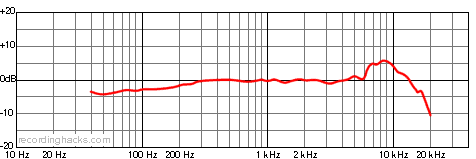 CAD Audio e1002
CAD Audio e1002
Supercardioid Condenser Microphone
The Equitek e1002 is a supercardioid FET condenser microphone with a Transsound electret capsule and CAD’s unique “equitek” amplifier circuit design.
It is a second-generation revision of the E100, a mic designed by CAD in the early 1990s.
The E100 was manufactured in the US, but in the early 2000s CAD moved most (or possibly all) of its microphone manufacturing to China, until the 2009 release of the E100S.
How did the E100 differ from the e1002?
We have identified a few differences, but the following list is neither official nor comprehensive:
- The e1002 was manufactured in China.
- The electret capsules differed, and were different sizes. The E100 capsule was manufactured by Primo. The e1002 capsule was a Transsound TSB-160A.
- The e1002 had a lower retail price than the original mic.
ProAudioReview, 2004
I did however have a 10-year old Equitek E200 on hand to compare the e1002 to. I know what you’re thinking… apples and oranges. Yes and no. Fact is, the original E100 and E200 shared electronics and diaphragms… Still it was interesting to see how the comparison played out. Saving you the suspense, the new e1002 sounded much better than my old E200.
The mic can be powered by either phantom power or by two 9V batteries. Unusually, phantom power is not used to drive the microphone’s amplifier circuit directly; rather, it charges two built-in rechargeable batteries, which are capable of driving the high current needs of the output circuit’s opamps during high-SPL transients.
CAD
Equitek microphones … do not use any discrete FETs. Instead, [they] use advanced high speed OpAmps (Operational Amplifiers). These OpAmps are individually laser trimmed for optimum performance and have very high gain. This allows a large amount of negative feedback to be used to significantly reduce any non-linearity. During transients, these OpAmps may require more current than typical phantom power supplies can deliver. The extra current demands are accommodated by our unique power supply design. Instead of using phantom power to operate the microphone, we use it to charge a pair of rechargeable batteries. This system creates a huge current reserve for the microphone’s electronics, yet there is no maintenance involved because the microphone automatically keeps the batteries charged during use.
A side-effect benefit of this design is that the mic will operate without 9V batteries or P48 for up to six hours, so long as the built-in rechargeable batteries are fully charged.
The capsule is an electret design, measuring approximately 13mm in diameter according to ProAudioReview. It is shockmounted within the mic’s headbasket to reduce handling noise.
Switches on the mic body provide a -20dB noncapacitive pad, a high-pass filter (-6dB/octave @ 80Hz), and a power cutoff for the 9V batteries.
The mic ships with an elastic, spider-type shockmount in a foam-lined carrying case.
Permalink: CAD Audio e100
Specifications
| Frequency Response - SupercardioidClick Graph to Compare! |
|---|
 |
| Pickup Patterns | Pads & Filters |
|---|---|
|
Supercardioid
(14 mV/Pa; 10-18,000 Hz) |
|
| Capsule Dimensions | Impedance | SPL/Noise |
|---|---|---|
| Diaphragm diameter: 13mm |
200 Ohms (Low) | Max SPL: 148 dB Self-noise: 19.0 dB(A) |
| Weight | Length | Max Diameter | Interface(s) |
|---|---|---|---|
| 590g (20.81oz) | 152mm (5.98'') | n/a |
|
| Power Specifications |
|---|
|
Did we get anything wrong on this page? Please let us know!

